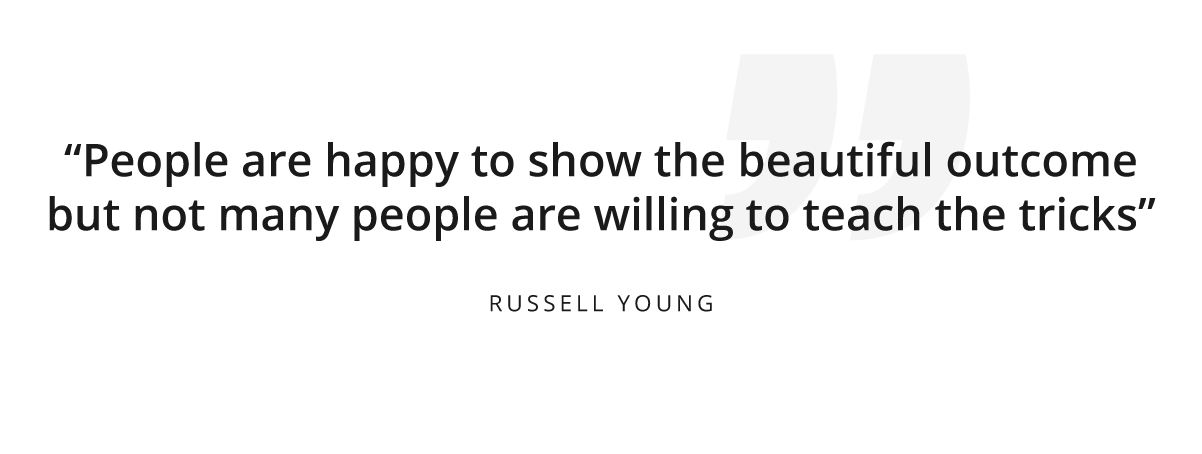The role of the Dental Prosthetist: Christian in conversation with Russell Young
-1.png?width=850&name=Blog%20Header%20(1)-1.png)
Christian Coachman recently spoke with Russell Young in an interview for the popular Coffee Break with Coachman series. These episodes feature guests from all aspects of dentistry, individuals who have excelled in their fields and embody the DSD values of collaboration, continuous learning and celebrating innovation.
From business to marketing to clinical to research, academics, laboratory technology and digital, each of the interviews is a conversation with a thought leader in their field, sharing their knowledge and experiences.
In this interview, the first of 2019, Christian and Russell spoke about their experiences as dental technicians and how this path led them to digital dentistry, particularly in the context of the role of the dental technician and dental prosthetist in Australia and how that impacts digital smile design.
Meet Russell Young
Christian Coachman:
“Russell Young is a dental technician focusing mainly on ceramics; that's his passion, as it is mine. Russell is also a dental prosthetist in Australia, which means he can treat patients; a common role in Australian dentistry. That has led Russell to combine both his skills as a technician and a ceramist and also to work clinically with patients helping dentists get the best results possible.”
The Dental Prosthetist
Christian Coachman:
“This is a very interesting concept. Here in Brazil there is always a discussion about what technicians can actually do in the mouth and how technicians can help the dentist. As a technician for 20 years I have worked in the patient's mouth a great deal, adjusting my work and helping the dentist before he would come and do his part. But in Australia you have dentists, you have technicians, but then you have a specific program where you become what is called the dental prosthetist or chairside technician. I love the name and I love the concept. Technicians all over the world do that anyway unofficially, but I think it's only in Australia, certain states in America and in Canada that they have this. It enables technicians to do prosthetic work in the patient’s mouth. Ceramic work does not always go perfectly from the clinic to the laboratory and back. Dentists around the world will know that once the provisionals are in, when it comes to you putting the ceramics in at the end, they don’t always match.
"There is a lot of work between transferring the provisionals into the mouth to going back to the lab and making sure the restorations are perfect. The case may look beautiful on the model but then when you try it in the mouth, there's a lot of detail that with experience as a technician and dentist, you will know how to fine-tune and not lose that quality. Also sometimes the trying in the mouth is great and then the technician leaves the room and the dentist bonds everything. But we see the patient and everything is kind of off-position. So it seems easy to try and place and bond 10 crowns but it’s not! Many things can go wrong.
I asked Russell to summarize some of the tricks that he uses to maintain the quality from the model through to the outcome.”
What are your tricks for maintaining quality throughout the process?
Russell Young:
“That’s a really good question because it’s something I do every day. We get some dentists at very high quality, some amazing dentists and some not so amazing ones. So the impressions often are not always great and any lab technician will tell you we spend a lot of time modifying the models. Once you make the restorations they fit on the model, but they don't necessarily fit in the mouth.
I spend a great deal of time trying to work with and adjust the contact points or the veneer or crown itself. What we are also looking for is the aesthetic result and this is where we work with the patient as well. The patient needs to see the result, and it is most important that the patient has the right emotional response to the porcelain work; they've had a great emotional response to provisionals but is the porcelain going to deliver that same emotional response?
Sometimes it doesn’t and it needs extra lab work to get it right. There’s not many people talking about these tricks. People are happy to show the beautiful outcome but not many people are willing to teach the tricks.”
Fine-tuning the fit
Russell explains:
“The design may look great on the model, but now it’s time for the try-in. The better the model the less the adjustment, but there are always little things that need fine-tuning. The model also doesn’t have the gum and the integration between the restoration and the gingiva is key to make everything planned in. So you need to have the skills to actually bring the restorations into the mouth. Step one is trying to fine-tune the fit.
The contact points may seem easy, but as you move the restorations you can change line angles. You can destroy the harmony by adjusting the context. You can miss the axis of the tooth and mess up with the inclination. You can open diasporas or black triangles.”
Dealing with Black Triangles
What if the work looks beautiful on the model, but when you get it in the mouth, you get black triangles?
Russell explains:
“If the provisionals aren’t great, you may get a little bit of tissue loss and can get black triangles, so patients aren’t very happy. Often you tell the patient, don’t worry, the filler will grow back, but you know from experience there are certain times where you have to add some by hand.”
Engaging with the patient
“I think a really key moment for the dentist (and I think that sometimes they don't quite understand this) is to engage the patient not just at the provisionals stage but at the insertion stage. Often the patients are numb, upside down and back to front; that's the way dentists often work. They should be sitting the patient up and allowing the patient to see the ceramic work before. I can't tell you how many times I have unhappy patients coming back and saying it's already bonded.”
Color: natural vs cosmetic
“Another big issue that I’ve found is color. This is the big issue moving forward and I noticed that on dentist forums where dentists are making wonderful veneers, just incredible quality of ceramic work but patient is unhappy because they’re too natural. What is the new natural? This is a very interesting conversation that we're going to continue to have now as we move forward - natural versus cosmetic,” Russell Continues.
Two different types of technicians
Christian Comments: "I always say that even though I graduated from dental school, throughout my whole career I have been a technician and I work only as a technician and I speak as a technician. Both Russell and I have this experience; I was inspired by technicians like Russell, by actually seeing people like him made me realize that I could be happy being a technician, because I could make this thing and work in the mouth. I believe there are two types of technicians:
- The technicians that can make things look beautiful on the model, but have no experience with patients
- The technicians that can also make things beautiful in the mouth, meaning that we understand all these tricks moving from a model to the mouth.
Technicians are psychologists; they can really engage emotionally with the patient, gain their respect and understand what will make the happy. We can really create this connection that sometimes is very hard for the dentist to do."
-1.png?width=1202&name=Qoute_2%20(2)-1.png)
Copy/Paste dentistry
Christian adds:
"This is one of the key aspects of the digital restorative workflow. We have talked about our work as analog technicians. But these are still the same challenges with or without digital. The digital workflow can help us on this specific challenge; to allow the patient to be emotionally comfortable, to allow us to test drive before committing to the project and to allow us to test drive prototypes before we fabricate the ceramics.
The idea of Copy/Paste dentistry gives a consistent process between the vision of the initial project, the digital wax up, the mock-up, the provisional and the final restoration. This is something that the digital approach has been helping us to do".
.png?width=1202&name=Qoute%20(1).png)
What is Russell's view as an analog technician?
“I'm very excited about copy/paste dentistry, which you would think would be a little unusual for me because I love doing my shapes and my forms and colors, but I find it so hard for technicians, even well trained technicians, to be able to get from the provisionals through to the final ceramic work and not inject some of their own artistic license and have the patient go ‘wow this is not what I expected’. So I love the idea of natural restorations and copy/paste dentistry is something I'm very excited about.”
“The concept is very simple; whatever works we want to copy and paste, whatever is not making the patient happy we want to modify, but modify during the process. If you think about a restorative workflow, you have an initial idea in the days of the diagnostic wax-up, today it’s a digital 3D design.
This initial idea can become a test drive, it can become a motivational or technical mock-up. This mock-up can become a guide for preps and after preps this design becomes the provisionals and then the provisionals become final restorations, so during this journey the final restoration is no longer almost a copy of the initial design. There are certain things during the process that the patient will want to change and improve as we go through these four steps, but no matter how perfect the initial project is, whatever is good we want to keep, whatever is not what we want to improve. That’s the beauty of copy/paste dentistry,” Christian concludes.
Watch the full interview with Russell Young here
If you have found this blog post interesting, why not watch the complete video with Russell Young and Christian Coachman in conversation here:
If you would like to know more about copy/paste dentistry and Digital Smile Design and how this innovative concept could transform how your dental clinic performs facially driven dentistry, visit our web page and sign up for a DSD residency now to start your DSD Journey:



